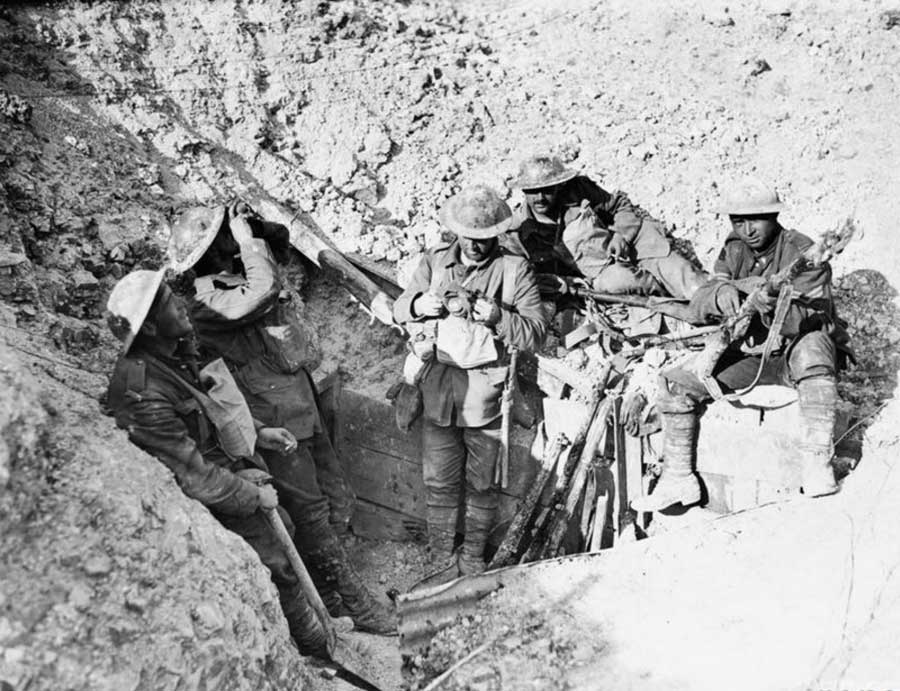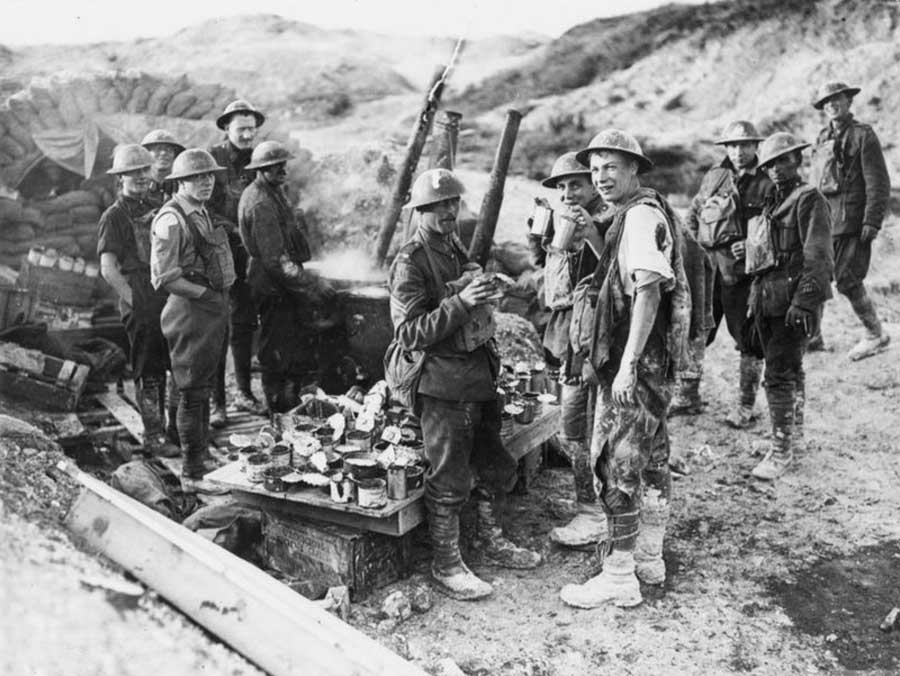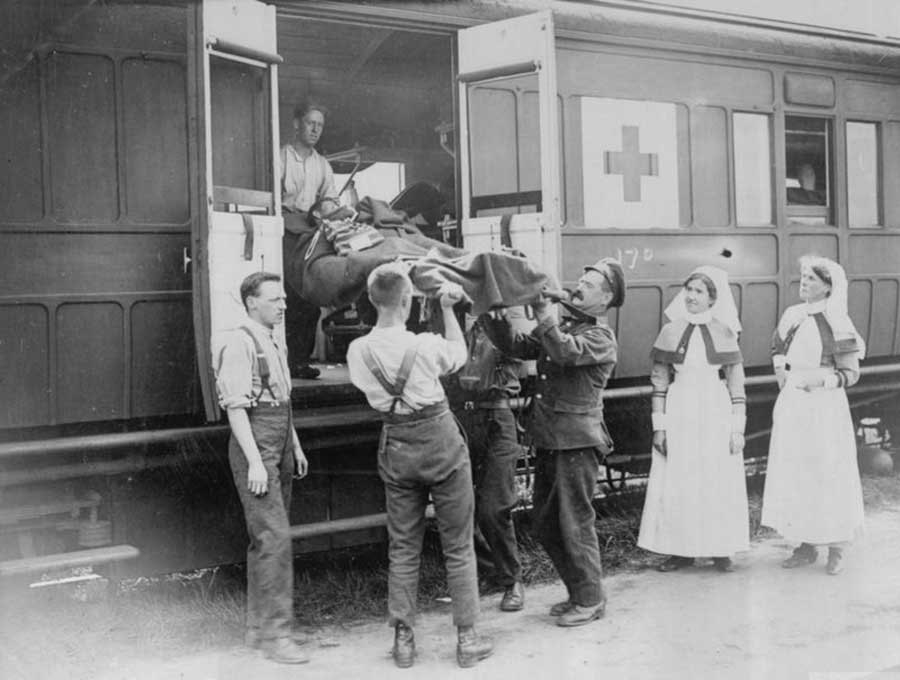The Battle of Hill 70
This publication is available upon request in alternate formats.
PDF Version
Canadian soldiers saw heavy action in the First World War and the names of some of their major battles—like Vimy Ridge and Passchendaele—still resonate today in our country’s collective memory. An important chapter in our wartime history that is less well remembered, however, came at Hill 70 in France where the Canadian Corps won an impressive victory in the summer of 1917.
The First World War
The First World War raged from 1914 to 1918 and was the bloodiest conflict that had ever been seen up to that time. The primary Allied powers included Britain (along with its overseas dominions like Canada), France, Russia, Italy and the United States. The opposing Central Powers were chiefly comprised of Germany, Austria-Hungary and the Ottoman Empire. Most of our country’s overseas troops would serve with the Canadian Corps in the trenches of the Western Front that snaked almost 1,000 kilometres across Belgium and northern France.
In the summer of 1917, the war was not going well for the Allies. Russia was wavering on the Eastern Front as the country began to be rocked by revolution while the French army was weakened by widespread mutinies. The German u-boat campaign at sea was strangling the vital flow of supplies that allowed Britain to continue fighting. The United States had recently entered the war but would need time to prepare before its troops joined the battle. The major Allied offensive at Passchendaele was bogging down in the mud of Belgium. Against this challenging backdrop, the Canadian Corps was called into action.
Hill 70 and Lens
Our country’s great victory at Vimy Ridge in April 1917 was soon followed by Lieutenant-General Arthur Currie (who had played an important role in planning and directing the battle there) being named commander of the Canadian Corps. Its first major action under his leadership would come in France at Hill 70 and Lens where British high commander Field Marshal Douglas Haig ordered the Canadians to attack to force the Germans to divert troops away from the heavy fighting farther north around Passchendaele.
Currie was initially directed to assault only Lens, a coal mining town a few kilometres north of Vimy Ridge. The war had largely reduced Lens to a blasted maze of ruined buildings which was studded with strong enemy defensive positions. After surveying the situation, though, Currie felt that his artillery would have trouble smashing the well-camouflaged German defences there and a direct attempt to send attacking troops into the town would result in terrible casualties. He persuaded his superiors to instead allow the Canadians to first capture the nearby high ground to the north (codenamed Hill 70 because it rose 70 metres above sea level). Currie’s clever plan was to take its slopes with a surprise assault, then quickly set up the Canadian defences to cut down the inevitable counterattacks that the Germans would launch as the enemy could never allow the strategically located hill to remain in Allied hands.
The Canadians carefully prepared in advance of this operation and our soldiers trained extensively. Allied artillery softened up the German positions in the area and trench raids were conducted south of Lens to mislead the enemy on where the main attack would come. On August 15, 1917, the offensive was launched and the Canadians soon seized most of its objectives on the slopes of Hill 70. The shocked Germans reacted as expected and flung a total of 21 counterattacks against our soldiers over the days that followed. The result was carnage as they advanced again and again into the deadly hail of bullets from 250 Canadian machine guns and were pounded by heavy artillery fire.
The fighting at Hill 70 was remarkably brutal to even the most battle-hardened of soldiers. Poison gas was widely used, often forcing the men to gasp for air inside their restrictive respirators as they struggled to see the advancing enemy through their fogged-up goggles. Many of our soldiers had to engage in desperate hand-to-hand combat against the tenacious German attackers who managed to reach the Canadian defensive lines.
Despite the Germans’ ferocious efforts, Hill 70 remained in the Canadians’ grasp. The Germans still held Lens, however, although it was now being swept by fire from our forces holding the commanding heights to the north. On August 21 and 23, it was the Canadians’ turn to again go on the offensive as they launched attacks on the town itself. It would also prove to be their turn to suffer major casualties as the German defenders poured heavy fire of their own on the exposed Canadian attackers.
After managing to capture the western portion of Lens, the Canadian attacks petered out in the face of stiff resistance and the Battle of Hill 70 came to an end by August 25. Despite failing to achieve all of its goals, it was a remarkable success for the Canadian Corps.
Heroism
Great courage was evident throughout the Canadian actions at Hill 70 and Lens. Six of our soldiers earned the Victoria Cross, the highest award for military valour that can be received, in the fighting there: Private Harry Brown, Company Sergeant Major Robert Hanna, Sergeant Frederick Hobson, Corporal Filip Konowal, Major Okill Massey Learmonth and Private Michael James O’Rourke. As a testament to the intensity of the fighting at Hill 70, Brown, Hobson and Learmonth sadly did not survive the battle to receive their medals.
Sacrifice
The First World War was a particularly bloody conflict and even relatively successful battles took a devastating toll. The fighting at Hill 70 and Lens was no exception and the 100,000-strong Canadian Corps suffered some 9,200 casualties between August 15 and 25, 1917. The Germans were hit even harder, with as many as 25,000 of their soldiers being killed, wounded or taken prisoner during this period.
More than 650,000 men and women served our country in uniform during the First World War. Those who gave their lives at Hill 70 and Lens were among the more than 66,000 Canadians who died in service during the conflict.
Legacy
As at Vimy Ridge, soldiers from coast to coast serving in all four Canadian divisions would see action together at Hill 70. Moreover, the battle was planned and carried out almost entirely by Canadians—a rarity in the First World War where our men usually fought as part of a larger British effort. The clever tactics that Currie employed in August 1917 helped the Allied leadership recognize that there were more effective ways to fight a conflict that had already taken a terrible toll in lives with little gain. Arthur Currie himself remarked at the time that Hill 70 was “…altogether the hardest battle in which the Corps has participated. It was a great and wonderful victory. GHQ [General Headquarters] regard it as one of the finest performances of the war.”
Our country’s impressive victory at Hill 70 was part of the unbroken series of Canadian military successes that marked the last two years of the conflict. Canada’s great sacrifices and achievements on the battlefields of Europe gained our country a new respect on the international stage. This esteem helped earn us a separate signature on the Treaty of Versailles that formally ended the First World War.
Canada Remembers Program
The Canada Remembers Program of Veterans Affairs Canada encourages all Canadians to learn about the sacrifices and achievements made by those who have served—and continue to serve—during times of war and peace. As well, it invites Canadians to become involved in remembrance activities that will help preserve their legacy for future generations.
- Date modified:


